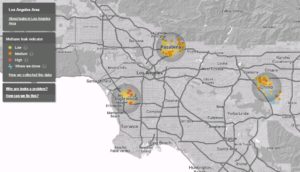Mapping the way forward on preventing powerful methane emissions
What do Boston, New York, Indianapolis and Syracuse all have in common? They’re all cities part of the Environmental Defense Fund’s (EDF) methane leaks interactive data map of where the methane leaks are located in a given city.
What do Boston, New York, Indianapolis and Syracuse all have in common? They’re all cities part of the Environmental Defense Fund’s (EDF) methane leaks tracking tool. Just this week, EDF unveiled Los Angeles as the latest city to be added to the interactive data map that’s a fascinating bird’s eye view of where the methane leaks are located in a given city. The Google map and data are the latest powerful additions to our arsenal of information better arming cities, states, environmentalists and the utilities and workers—including more than 4,000 members of the Utility Workers Union of America employed at Southern California Gas—doing this work to prevent methane leaks as a potent source of emissions.
What, where and how
Even a cursory look at EDF’s map of Los Angeles quickly reveals methane leaks are all over the city. As this distribution infrastructure ages—especially in the largest and oldest cities across the country—it’s becoming an increasing problem. Uncombusted methane lost through the system, pound for pound, has at least 21 times the global warming potential of carbon dioxide over a 100-year time frame, making it a truly potent contributor to climate change.
The potency of methane in combination with the aging distribution system poses a growing threat, but also an opportunity. The scope of the problem is that the U.S. consumes approximately 25 trillion cubic feet of natural gas annually. Natural gas for consumers and businesses run through approximately 1.25 million miles of distribution pipelines in communities throughout the U.S. Nine percent of our nation’s natural gas distribution pipelines—approximately 112,000 miles worth—are made from leak-prone materials such as cast iron and unprotected steel and in many cases date back beyond World War II.
Why is repair and replacement important?
The opportunities presented by the aging distribution system are both environmental and economic. Repairing and replacing natural gas distribution pipelines has the potential to prevent the emission of 81 million metric tons of climate change pollution—the equivalent of taking 17 million cars off the road for a year. If we’re going to truly make an impact limiting emissions over the next few years to meet both domestic and global emissions commitments, it will be necessary to think creatively about news ways to do that.
Making distribution pipeline repairs and upgrades deliver for the economy by putting people to work. A BlueGreen Alliance report—Interconnected—explores the scenario of moving from 30- to 10-Year pipeline replacement scenario. Accelerating the timeline for repairing leak-prone sections of our nation’s natural gas pipeline distribution system create more than 300,000 good, family-supporting jobs across the economy, save consumers $1.5 billion in charges for lost gas.
Knowing which cities and neighborhoods are seeing the most leaks is one of many steps in preventing emissions in the first place. The EDF’s mapping tool is working to educate and engage a wider audience about this problem. In partnership with EDF, the BlueGreen Alliance is urging the administration to act boldly with supportive policies to achieve emissions reductions and working with partners and allies to develop ways to reap all possible economic impacts.
This important work is a down payment on our commitment to do better where we can. The economic opportunity and the environmental repercussions are an opportunity that cannot be missed.
